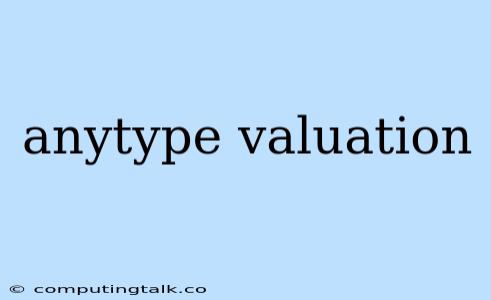Anytype is a powerful and versatile knowledge management platform that has gained significant traction in recent years. Its innovative features and intuitive interface have attracted users seeking to organize their thoughts, projects, and information in a structured and interconnected manner. As Anytype continues to evolve, it's natural to wonder about its valuation and potential future trajectory.
What is Anytype Valuation?
Anytype valuation refers to the estimated monetary worth of the company. This valuation can be determined using various methods, including:
- Private market transactions: This involves analyzing recent investments in Anytype or similar companies to gauge market sentiment and investor appetite.
- Comparable company analysis: This method compares Anytype's key metrics (e.g., revenue, user base, growth rate) to publicly traded companies in the same industry to derive a valuation range.
- Discounted cash flow (DCF) analysis: This approach involves projecting future cash flows and discounting them back to the present value to determine the company's intrinsic worth.
Factors Affecting Anytype Valuation
Several factors can influence Anytype's valuation, including:
- User growth and engagement: A rapidly growing user base and high engagement levels indicate strong product-market fit and future potential.
- Revenue model and monetization: The way Anytype generates revenue and its ability to scale its monetization strategy will directly impact its valuation.
- Technology and innovation: Anytype's innovative features and its ability to stay ahead of the curve in the knowledge management space will be key to attracting investors and achieving a high valuation.
- Competitive landscape: The presence of competing platforms and the strength of their offerings will affect Anytype's perceived market share and valuation.
- Market conditions: Overall economic conditions and investor sentiment can also influence the valuation of tech companies like Anytype.
How to Estimate Anytype Valuation
While it's impossible to provide an exact Anytype valuation without access to internal company data, you can get an idea by considering the following:
- Analyze user growth and engagement: Look at public data and reviews to assess the rate of user adoption and engagement levels.
- Compare Anytype to similar platforms: Identify publicly traded companies in the knowledge management or productivity space and compare their valuations to Anytype's key metrics.
- Consider Anytype's revenue model: Assess the potential for revenue generation and the scalability of its monetization strategy.
- Evaluate Anytype's technology and innovation: Assess the uniqueness and competitiveness of Anytype's features and its roadmap for future development.
- Consider the market conditions and investor sentiment: Analyze the current economic landscape and the general investor appetite for technology startups.
Impact of Anytype Valuation
Anytype valuation can have several impacts:
- Funding rounds: A higher valuation can lead to larger funding rounds, providing Anytype with more resources for growth and development.
- Acquisition potential: A strong valuation can attract potential acquirers, who may see Anytype as a valuable asset for their portfolio.
- Company culture and employee morale: A positive valuation can boost employee morale and attract top talent.
- Public perception: A high valuation can enhance Anytype's brand image and reputation in the market.
Conclusion
Anytype valuation is a complex and dynamic metric influenced by various factors. It's impossible to provide a precise valuation without access to internal company data. However, by analyzing key metrics, comparing Anytype to similar companies, and considering market conditions, you can gain insights into its potential worth and its future trajectory. Ultimately, Anytype's valuation will reflect its ability to deliver value to users, attract investors, and maintain a competitive position in the knowledge management landscape.
